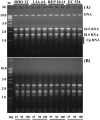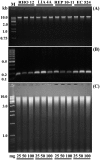A simple and effective method for high quality co-extraction of genomic DNA and total RNA from low biomass Ectocarpus siliculosus, the model brown alga
- PMID: 24867404
- PMCID: PMC4035266
- DOI: 10.1371/journal.pone.0096470
A simple and effective method for high quality co-extraction of genomic DNA and total RNA from low biomass Ectocarpus siliculosus, the model brown alga
Erratum in
- PLoS One. 2014;9(7):e101190
Abstract
The brown seaweed Ectocarpus siliculosus is an emerging model species distributed worldwide in temperate coastal ecosystems. Over 1500 strains of E. siliculosus are available in culture from a broad range of geographic locations and ecological niches. To elucidate the molecular mechanisms underlying its capacity to cope with different environmental and biotic stressors, genomic and transcriptomic studies are necessary; this requires the co-isolation of genomic DNA and total RNA. In brown algae, extraction of nucleic acids is hindered by high concentrations of secondary metabolites that co-precipitate with nucleic acids. Here, we propose a reliable, rapid and cost-effective procedure for the co-isolation of high-quality nucleic acids using small quantities of biomass (25-, 50- and 100 mg) from strains of E. siliculosus (RHO12; LIA4A; EC524 and REP10-11) isolated from sites with different environmental conditions. The procedure employs a high pH extraction buffer (pH 9.5) which contains 100 mM Tris-HCl and 150 mM NaCl, with the addition of 5 mM DTT and 1% sarkosyl to ensure maximum solubility of nucleic acids, effective inhibition of nuclease activity and removal of interfering contaminants (e.g. polysaccharides, polyphenols). The use of sodium acetate together with isopropanol shortened precipitation time and enhanced the yields of DNA/RNA. A phenol:chlorophorm:isoamyl alcohol step was subsequently used to purify the nucleic acids. The present protocol produces high yields of nucleic acids from only 25 mg of fresh algal biomass (0.195 and 0.284 µg mg(-1) fresh weigh of RNA and DNA, respectively) and the high quality of the extracted nucleic acids was confirmed through spectrophotometric and electrophoretic analyses. The isolated RNA can be used directly in downstream applications such as RT-PCR and the genomic DNA was suitable for PCR, producing reliable restriction enzyme digestion patterns. Co-isolation of DNA/RNA from different strains indicates that this method is likely to have wider applications for intra- and inter-specific studies on other brown algae.
Conflict of interest statement
Figures




Similar articles
-
Global expression analysis of the brown alga Ectocarpus siliculosus (Phaeophyceae) reveals large-scale reprogramming of the transcriptome in response to abiotic stress.Genome Biol. 2009;10(6):R66. doi: 10.1186/gb-2009-10-6-r66. Epub 2009 Jun 16. Genome Biol. 2009. PMID: 19531237 Free PMC article.
-
Development and physiology of the brown alga Ectocarpus siliculosus: two centuries of research.New Phytol. 2008;177(2):319-332. doi: 10.1111/j.1469-8137.2007.02304.x. New Phytol. 2008. PMID: 18181960 Review.
-
The genome-scale metabolic network of Ectocarpus siliculosus (EctoGEM): a resource to study brown algal physiology and beyond.Plant J. 2014 Oct;80(2):367-81. doi: 10.1111/tpj.12627. Epub 2014 Aug 27. Plant J. 2014. PMID: 25065645
-
Transcriptomic and metabolomic analysis of copper stress acclimation in Ectocarpus siliculosus highlights signaling and tolerance mechanisms in brown algae.BMC Plant Biol. 2014 May 1;14:116. doi: 10.1186/1471-2229-14-116. BMC Plant Biol. 2014. PMID: 24885189 Free PMC article.
-
Biosynthetic pathway and health benefits of fucoxanthin, an algae-specific xanthophyll in brown seaweeds.Int J Mol Sci. 2013 Jul 2;14(7):13763-81. doi: 10.3390/ijms140713763. Int J Mol Sci. 2013. PMID: 23820585 Free PMC article. Review.
Cited by
-
SILEX: a fast and inexpensive high-quality DNA extraction method suitable for multiple sequencing platforms and recalcitrant plant species.Plant Methods. 2020 Aug 10;16:110. doi: 10.1186/s13007-020-00652-y. eCollection 2020. Plant Methods. 2020. PMID: 32793297 Free PMC article.
-
Extraction, Structural Characterization, and In Vivo Anti-Inflammatory Effect of Alginate from Cystoseira crinita (Desf.) Borry Harvested in the Bulgarian Black Sea.Mar Drugs. 2023 Apr 16;21(4):245. doi: 10.3390/md21040245. Mar Drugs. 2023. PMID: 37103384 Free PMC article.
-
Phenylboronic Acid-Functionalized Micelles Dual-Targeting Boronic Acid Transporter and Polysaccharides for siRNA Delivery into Brown Algae.JACS Au. 2024 Mar 22;4(4):1385-1395. doi: 10.1021/jacsau.3c00767. eCollection 2024 Apr 22. JACS Au. 2024. PMID: 38665671 Free PMC article.
-
The complete chloroplast genome of the brown alga Saccharina sp. ye-B (Laminariaceae: Phaeophyceae) from Sakhalin, Russia.Mitochondrial DNA B Resour. 2021 Feb 19;6(2):648-649. doi: 10.1080/23802359.2021.1878964. Mitochondrial DNA B Resour. 2021. PMID: 33659710 Free PMC article.
-
Utilizing Dichloromethane as an Extremely Proficient Substitute for Phenol/Chloroform in Extracting RNA with Exceptional Purity from Woody Tissues of Coconut.Methods Protoc. 2023 Aug 26;6(5):75. doi: 10.3390/mps6050075. Methods Protoc. 2023. PMID: 37736958 Free PMC article.
References
-
- Sáez CA, Pérez-Matus A, Lobos MG, Oliva D, Vásquez JA, et al. (2012) Environmental assessment in a shallow subtidal rocky habitat: Approach coupling chemical and ecological tools. Chemistry and Ecology 28: 1–15.
-
- Smith SDA (1996) The macrofaunal community of Ecklonia radiata holdfasts: Variation associated with sediment regime, sponge cover and depth. Australian Journal of Ecology 21: 144–153.
-
- Smith SDA (1996) The effects of domestic sewage effluent on marine communities at Coffs Harbour, New South Wales, Australia. Marine Pollution Bulletin 33: 309–316.
-
- Villegas MJ, Laudien J, Sielfeld W, Arntz WE (2008) Macrocystis integrifolia and Lessonia trabeculata (Laminariales; Phaeophyceae) kelp habitat structures and associated macrobenthic community off northern Chile. Helgoland Marine Research 62: S33–S43.
-
- Baldauf SL (2003) The deep roots of eukaryotes. Science 300: 1703–1706. - PubMed
MeSH terms
Substances
LinkOut - more resources
Full Text Sources
Other Literature Sources

